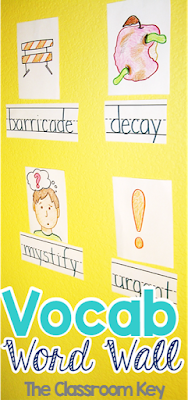About Me
I have some tips for you about implementing a vocabulary word wall, but first, a little about me: I taught 2nd grade for five years and was a library media specialist for three years. I have a 9-year-old girl and a 1-year-old boy. We love living in Colorado!
This is our dog, Chuck. He wasn't very excited about the neighborhood luau in this photo ; )
Vocabulary Word Walls
On to word walls! I frequently see word walls for sight words but another way to use them is to boost vocabulary. This would be especially appropriate for students in 2nd grade and above who typically don't need as much support with sight words.
One year I had a juggernaut of a word wall (speaking of vocabulary...haha!) that took up lots of space and had a place for each letter. Each day when I read my students a picture book, I introduced a tricky word I knew would be in the book and had a picture to represent it. After the read aloud we would add the word and the picture to the wall and refer back to it later. While I think this was beneficial for my students, especially since they were all English language learners, it did get a bit overwhelming, and I'm not sure we interacted with the old words enough.
I find teaching to frequently be about finding creative solutions to problems. They key to solving the unweidly word wall problem.....is to create a mini word wall!
Use 7 to 10 Words at a Time-
Using a smaller number of words has a few different benefits. It's easier for students to look for examples of the words in context if they're focused on a smaller number of them. Also, displaying the words takes up less space on the wall. You don't need a spot for each letter, just post the words like a list. Students are more likely to remember the words if they get several interactions with a small number of words rather than just skimming over a large number of words.
Pull Words from Books or Topics of Study -
New words will be more meaningful to students if they are connected to a book they have read or a science or social studies topic they have been studying.
Interact with the Words Frequently -
Word walls are of limited value if the words are talked about once, posted, and then never revisited. Students need several chances to hear, see, and use a new word in order to adopt it into their own vocabulary. More ideas for interacting with word walls are posted below.
Include Pictures -
Including pictures with vocabulary words will help jog students' memories. Reminder pictures can be the difference between students being able to use the word wall independently and students needing help with or just not using the word wall.
Change them out Occasionally -
If a word has been on the word wall for a while and students seem comfortable with it, change it out with a new word. Little by little your mini word wall will morph throughout the year.
So what exactly is this "interacting" with word walls? Here are some ideas that can be implemented in those little five minute gaps you find yourself in every so often:
Thanks for stopping by, and happy teaching!












they subtly influence mood, focus, and overall user experience. With modern advancements in display technology and digital artistry, the demand for premium, high-resolution wallpapers has skyrocketed, making it easier than ever to transform any device into a visually engaging space.https://colornjoy.com/blogs/halloween-wallpapers
ReplyDeletehttps://colornjoy.com/blogs/hello-kitty-wallpapers
https://colornjoy.com/blogs/hello-kitty-wallpapers/lock-screen-hello-kitty-wallpaper-iphone-download-1qi7z82u2
https://colornjoy.com/blogs/basketball-wallpapers/nike-basketball-wallpaper-4k-hd-9sg9r45r4
Canvas prints with detailed textures large wall art
ReplyDelete